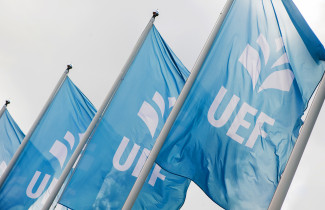The biggest cause of climate change is the use of fossil raw materials. According to a new book Forest Bioeconomy and Climate Change, the use of fossil raw materials cannot be eliminated without replacement also by forest bioeconomy products.
The role of the forest sector in mitigating and adapting to climate change is important and diverse. However, making full use of the forest bioeconomy in mitigating and adapting to climate change requires climate-smart forestry tailored to local conditions.
“Isn’t it surprising that dead forests – for coal results from the decomposition of forests – should annually supply a larger volume of raw material than live forests?” said forest visionary Egon Glesinger already in 1949. This is still true today, as world coal production is about double that of wood production. A new book “Forest Bioeconomy and Climate Change” considers how this situation can be changed in a sustainable way. The book, which will be published by Springer (open access) later this year, is the first science-based book on the subject. The book’s pre-published manuscript is now freely available at ResearchGate: https://www.researchgate.net/publication/358769825_Forest_Bioeconomy_and_Climate_Change
In the book, 28 European researchers look at the role of the forest bioeconomy in mitigating and adapting to climate change. The book is based on the FORBIO project (2015–2021) funded by the Strategic Research Council of the Academy of Finland, coordinated by the University of Eastern Finland and partnered by the European Forest Institute, the Finnish Meteorological Institute, the Natural Resources Institute Finland and the Finnish Environment Institute.
Reducing the use of fossil fuels is the key
Globally and in the EU, around 75-90% of CO2 emissions come from coal, oil and natural gas. For this reason, the core issue in the fight against climate change is the phasing out of fossil-based products. Achieving this goal is not possible without also using forest-based bioproducts for the purposes for which we use oil, coal and gas today, says Lauri Hetemäki, Professor of Practice at the University of Helsinki and Senior Researcher at the European Forest Institute.
Reducing the use of fossil raw materials in the EU and replacing them with bio-based products requires developing more new innovations in the forest bioeconomy, improving the resource efficiency and recyclability of already available bio-based products, and promoting the environmental sustainability of the bioeconomy, says Hetemäki.
The forest sector can contribute to mitigating climate change in three ways - forests can act as carbon sinks and storage, forest-based products can replace fossil products and, in addition, they can store carbon even for centuries. In order to achieve the desired climate benefits of forests, forests must also adapt to changing climate and withstand the increasing risks of disturbances due to this. Therefore, the ability of forests to mitigate climate change depends also on the adaptation of forests to climate change - which is why both must be promoted at the same time, says Professor Heli Peltola, Director of the FORBIO project at the University of Eastern Finland.
They way forward: climate-smart forestry
U.S. journalist Henry Mencken once said that "There is an answer to every complex problem that is clear, simple, and wrong." This is also true of the role of the forest sector in mitigating climate change - there is not only one right way to do it. Utilizing the forest sector to mitigate climate change requires a holistic approach, says Professor Jyrki Kangas, Deputy Director of the FORBIO project at the University of Eastern Finland. There is a need both to use forests to sequester and store carbon and to produce wood for forest bioproducts to replace fossil raw materials. All of these are needed for many different reasons, as the book shows.
The book suggests climate-smart forestry as an approach to harnessing the forest sector to mitigate and adapt to climate change. The approach is based on three main objectives:
1. Reduction of greenhouse gas emissions (forest sinks and storage, replacement of fossil fuels, carbon storage of forest products)
2. Adapting forests to climate change
3. Sustainable increase of economic well-being based on forestry
How these three goals are best achieved depends on local circumstances - the measures required for climate-smart forestry must be tailored to the forests and forest sectors of different countries. In addition, the optimal strategy may also need to be readjusted over time as climate change progresses. The book illustrates the application of climate-smart forestry in Finland, Spain, Germany and the Czech Republic, i.e., in EU countries with quite different forests and forest sectors.
Maximize synergies, minimize trade-offs
Although forests are a renewable resource, they are always limited in relation to their diverse needs. Therefore, the willingness of forest owners and society to take forest management measures to mitigate climate change also depends on how they affect all the other benefits of forests. The more synergies are found and the fewer trade-offs there are, the more likely and effectively they can be realized. The effectiveness of climate action must therefore be assessed in its socio-economic and ecosystem context.
For example, if forest-related measures are assessed solely from a climate perspective, it may not be possible to implement these measures effectively. Therefore, forest-related wood production and biodiversity objectives, for example, should be taken into account at the same time when planning these measures. This requires the rejection of either-or thinking. The book indicates various actions that can be used to increase synergies between different objectives and reduce side effects.
Adapting forests to climate change is becoming increasingly important
Science is quite unanimous that with climate change, the various risks of forest disturbances will increase. Large-scale disturbances caused by extreme weather events, such as droughts, storms and forest fires, must be taken into account when defining measures to adapt to a changing climate. There is also a broad consensus that, where possible, increasing the growing of mixed forests and reducing monoculture forests will improve the conditions for forests to adapt to changing climate, or at least reduce the adverse effects of climate change. Likewise, the use of tree species and provenance best suited to the specific habitat when reforesting is a good way to prepare for a changing climate.
The fundamental transformation of our society towards carbon neutrality and sustainable development is the greatest challenge of our time. A viable forest bioeconomy supports the adaptation of forests to climate change, but also vice versa. However, tax expenditures alone are unlikely to be able to finance large-scale measures to adapt forests to a changing climate; this will also require investments from forest owners and forest industry.
Climate mitigation must be implemented in such a way that people consider it just. Otherwise, there is a danger that the whole process will derail and the transition will not take place efficiently and quickly enough. It is therefore important that the interests of those working in the forest sector and forest owners are also taken into account in the planning of climate change mitigation measures. This is likely to increase the effectiveness of the forestry sector's efforts to mitigate climate change.
The book was funded by the FORBIO project of the Strategic Research Council of the Academy of Finland and the UNITE flagship competence centre of the Academy of Finland. The grant from the Finnish Forest Foundation made it possible to publish the book as open access.
More information:
Lauri Hetemäki, Professor of Practice, University of Helsinki and Senior Researcher, European Forest Institute. 050 3777 692 / [email protected]
Jyrki Kangas, Professor, University of Eastern Finland. 050 344 9888 / [email protected]
Heli Peltola, Professor, University of Eastern Finland. 040 588 0005 / [email protected]
Book: Hetemäki, L., Kangas, J. & Peltola, H. (eds.) 2022. Forest Bioeconomy and Climate Change. Managing Forest Ecosystems vol. 42. Springer. ISSN: 2352-3956 (electronic), 1568-1319 (print), ISBN: 978-3-030-99205-7 (hard-cover).
Book pre-print manuscript available for free download at ResearchGate: https://www.researchgate.net/publication/358769825_Forest_Bioeconomy_and_Climate_Change




